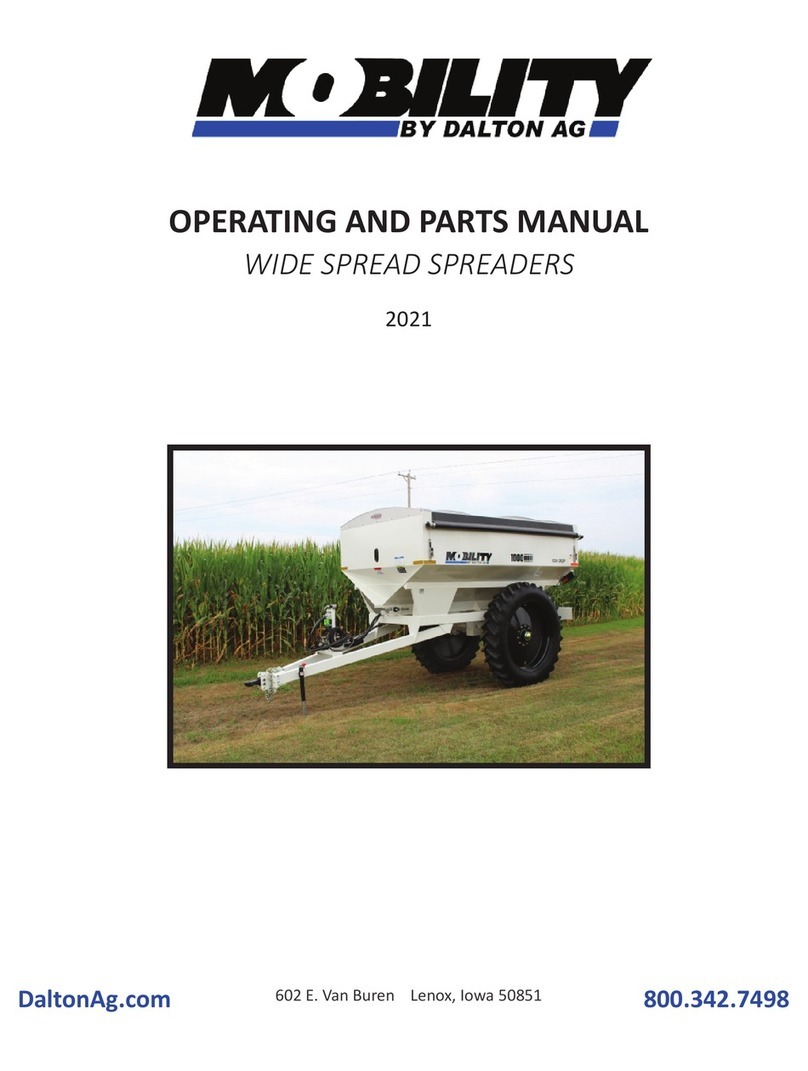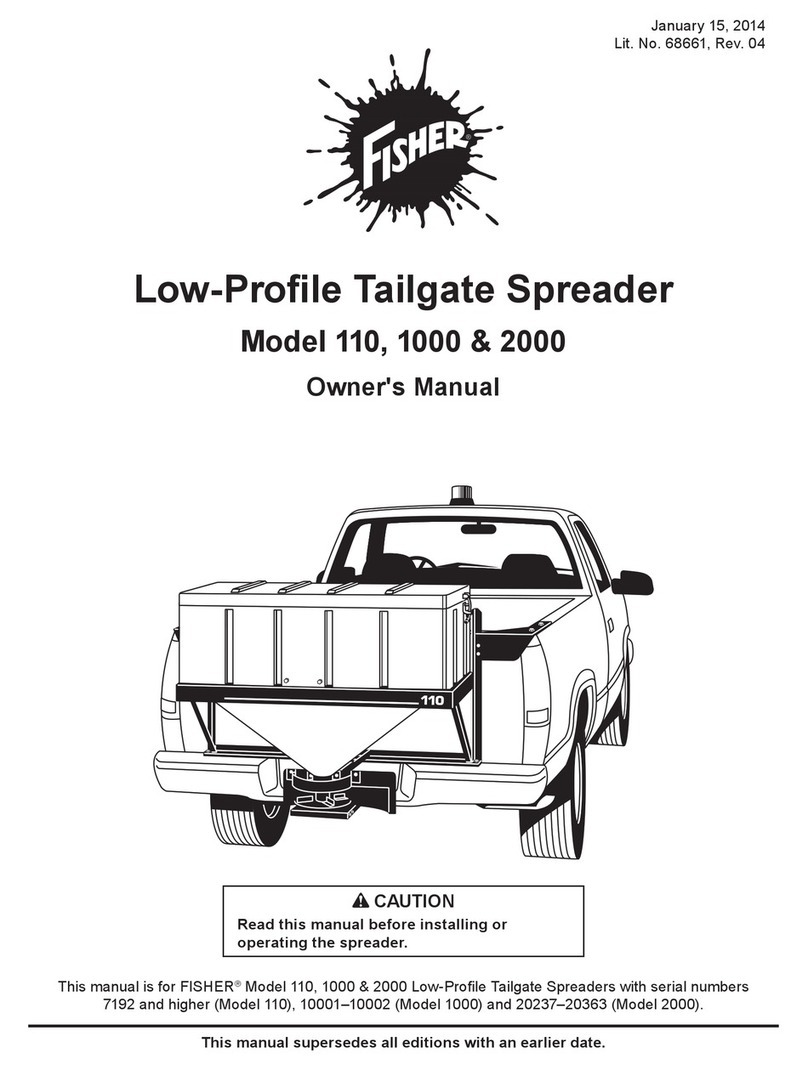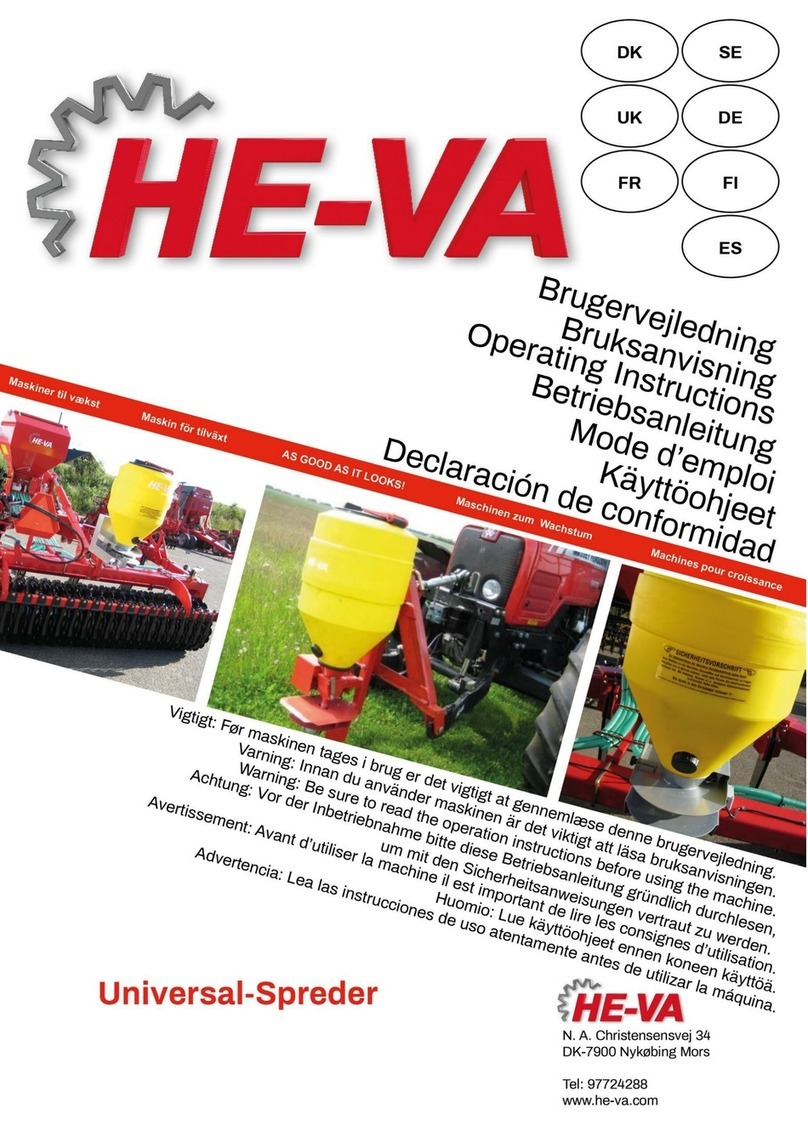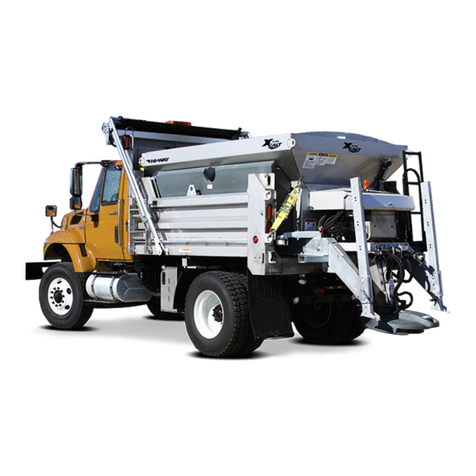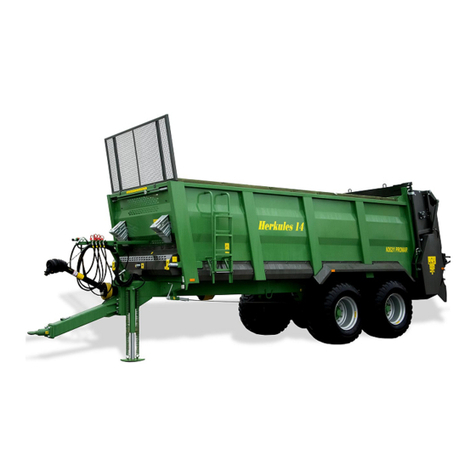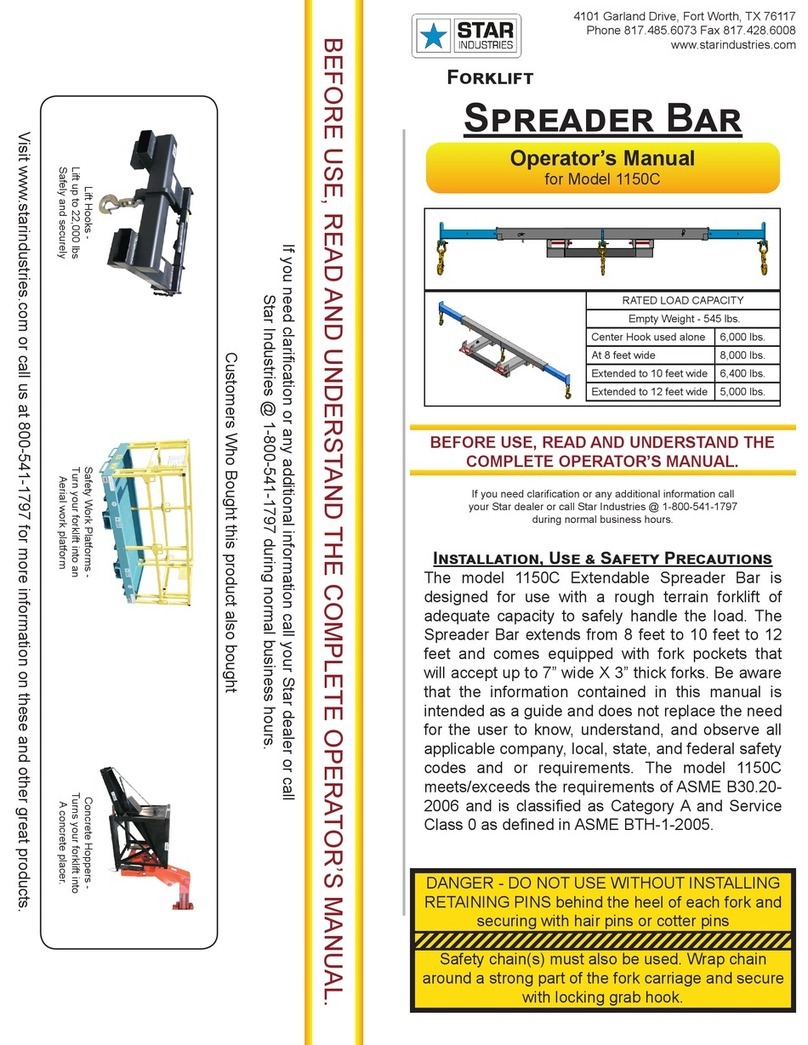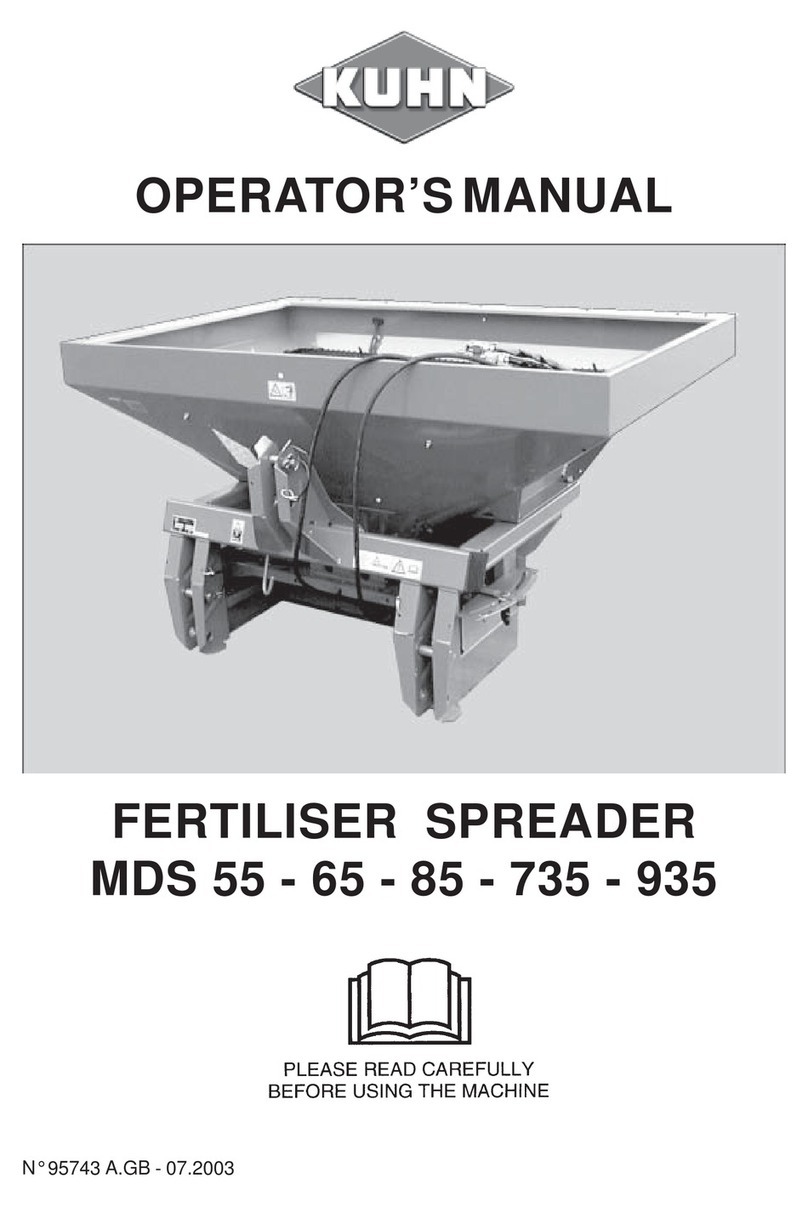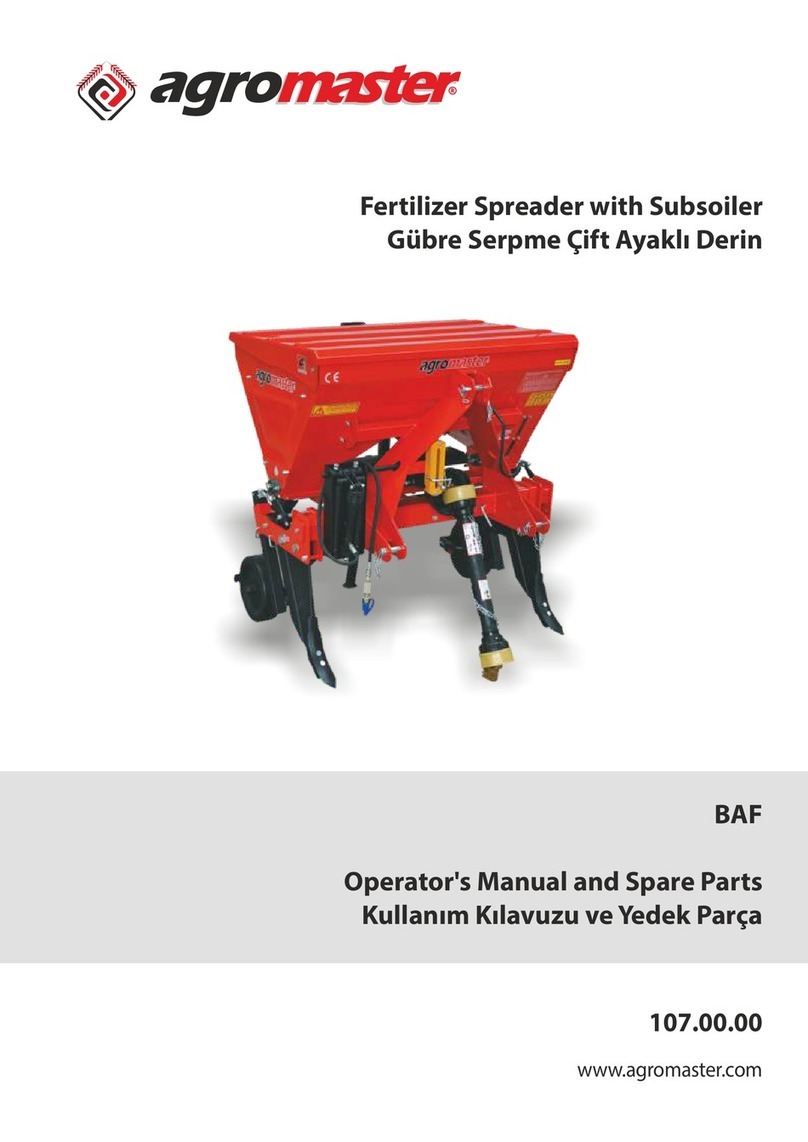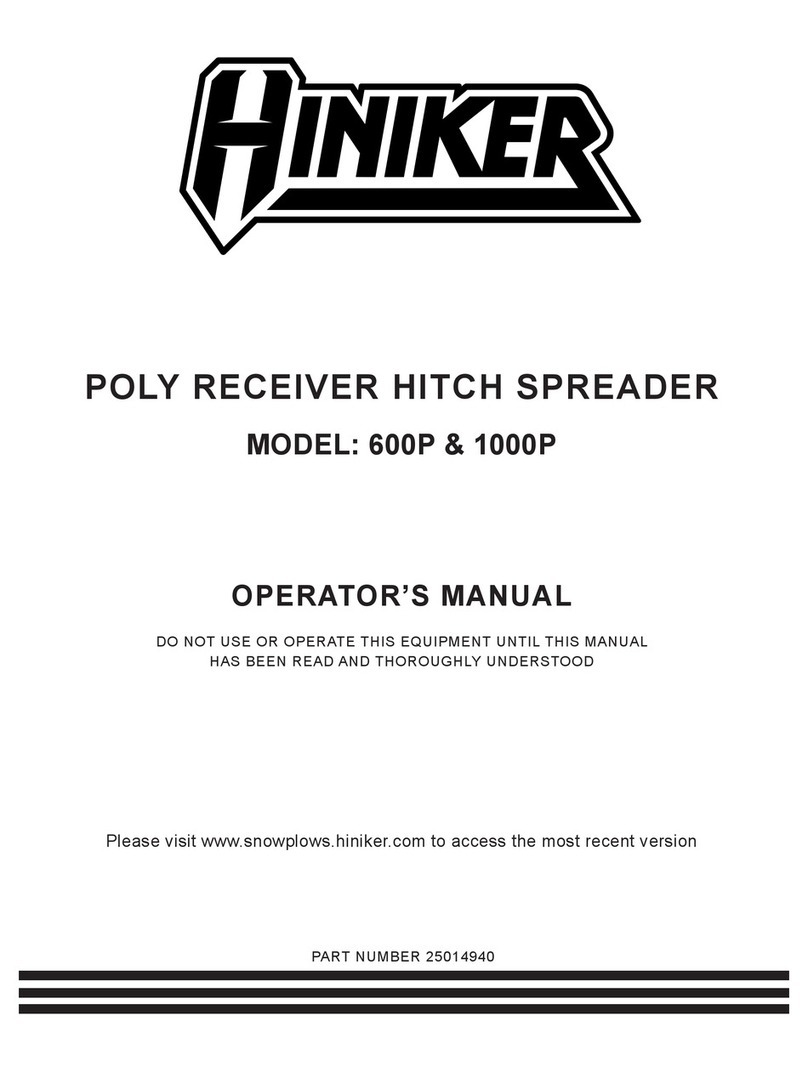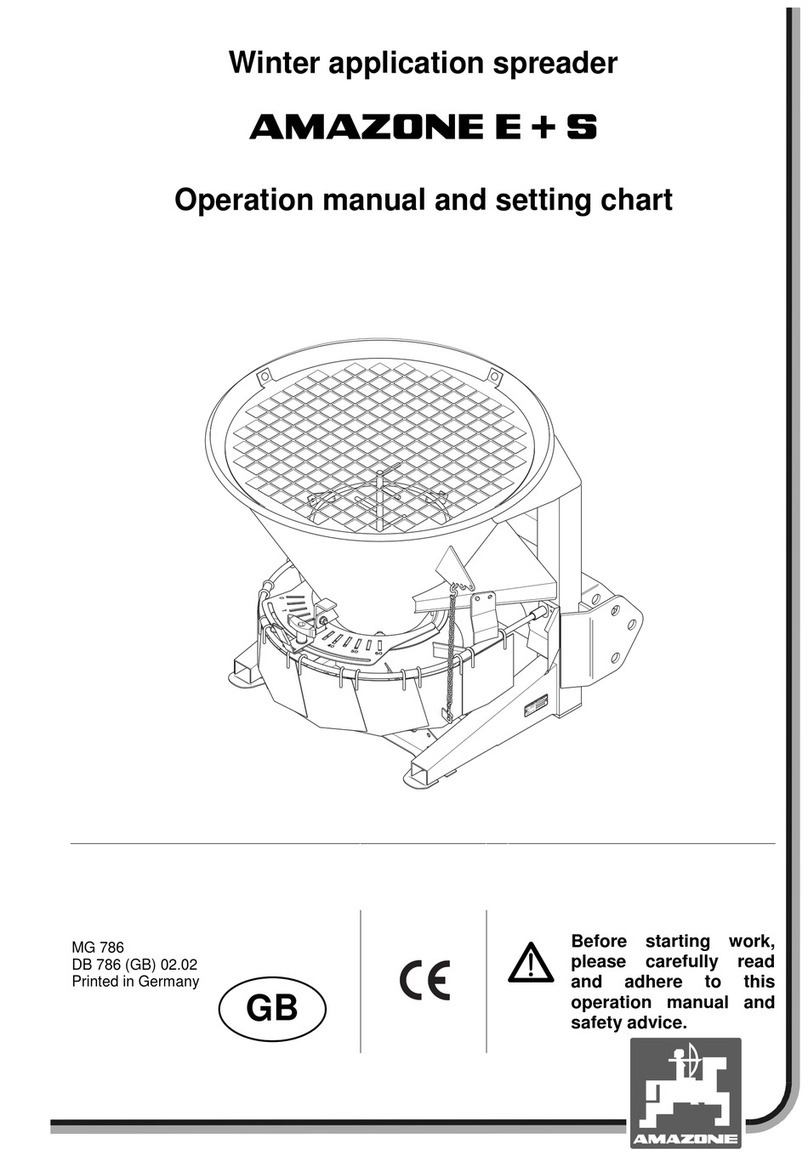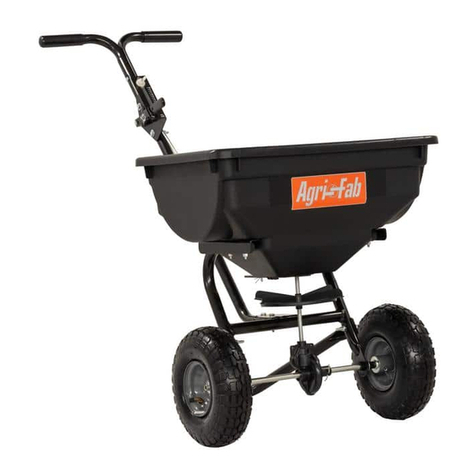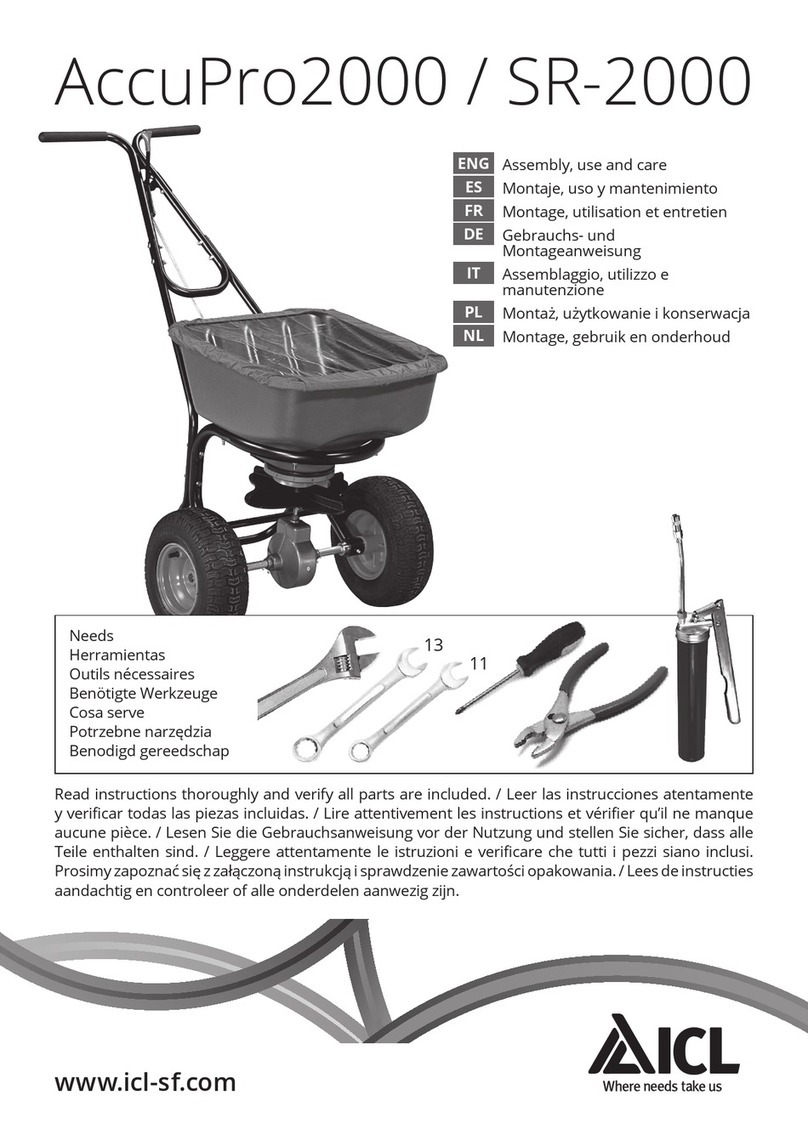STOLTZFUS SPREADERS WC 50 User manual

STOLTZFUS
SPREADERS
OWNERS MANUAL
"W-Chain" SPREADER
WC 50
Serial Number: ______________
Model Number: _ T S C 0 S 5 _
Purchase Date: / /
mfg by: STOLTZ MFG., LLC
121 MORGAN WAY
PO BOX 527
MORGANTOWN, PA. USA
19543
TEL: +1-610-286-5146

TABLE OF CONTENTS
WARRANTY
Warranty Claim Procedure
Warranty Registration Form
SECTION 1
:
Safety Notice
SECTION 2: Specifications
SECTION 3: Preparation For Use
SECTION 4: Spreader Hookup and Operation
SECTION 5: Lubrication and Maintenance
Maintenance Schedule
Lubrication Points
End of Season Storage
SECTION 6: Calibrating Your Spreader
SECTION 7: Application Rate Calculations
SECTION 8: Replacement Parts

WARRANTY
Stoltz Mfg., LLC warrants, for six months from the date of purchase, to the original
owner, that each spreader is free from defects in either material or workmanship, provided that
it has been adequately maintained and used under normal operating conditions.
This warranty covers only those items, parts and assemblies manufactured by Stoltz Mfg., LLC.
Parts manufactured by others carry only the warranty offered by the original manufacturer.
Stoltz Mfg., LLC's obligation under this warranty is limited to correcting the defect,
without charge, at its factory or as arranged by its Dealer. Before acceptance of any
\Varranty claim, the item must be examined by Stoltz Mfg., LLC and must be found to
have been defective. The defective item may be replaced or repaired to fulfill the
obligations of this warranty.
This warranty shall not apply to any items damaged through misuse, abuse, accident, repair,
overloading or lack of adequate maintenance.
This warranty shall not apply to any items that are worn through normal use.
All items that are considered as normal maintenance will not be covered by this warranty, nor
will damage caused by failure to perform maintenance. This includes tightening of nuts, bolts,
clamps, set screws, etc. Damage caused by loose fittings is not covered
by warranty.
Stoltz Mfg., LLC shall under no circumstances be liable for any incidental or consequential
damages arising from loss of property or other damages or losses owing to the failure or use of
Stoltz products beyond the cost of repair or replacement of any defective part.
Stoltz Mfg., LLC makes no warranty of fitness or merchantability. No other warranty,
expressed or implied, is made by Stoltz Mfg., LLC beyond the terms expressed herein.
No person, agent or dealer is authorized to give any other warranty on the behalf of Stoltz
Mfg., LLC.

WARRANTY
CLAIM PRO CEDUR E
1. Contact Stoltz Mfg.. LLC directly or your dealer. Obtain aReturn Goods Authorization
(RGA) number. Your purchase date and serial number will be required.
2. In certain cases, you
will
be required to return the part or the entire spreader to Stoltz or its
dealer for inspection.
3. When parts are returned for inspection, you will be required to pre-pay the freight charges.
4. If parts are shipped by Stoltz Mfg., LLC before avalid warranty request has been accepted, you
will be invoiced by Stoltz for the parts. The issuance of an RGA number does not guarantee that
the request will be granted.
You must complete and return the Warranty Registration form below within 2 w
eeks
of the
purchase date.
NOTE: Read enclosed
SAFETY
NOTICE before
submitting.
Cut Here---------------------------------------------------------------------------------------------------------------Cut Here
Warranty Registration Form
Return to:
Stoltz Mfg., LLC
PO Box 527
Morgantown, PA 19543
Please Print or Type:
Name __________________________________________
Address: ________________________________________
________________________________________
City: _______________________State _______ Zip Code _________
Phone:___________________
T___________ M____________ ____________
Model Number Serial Number Purchase Date
I hereby confirm that I have read the enclosed SAFETY NOTICE.
Owners
Signature:______________________________ Date:_____________
Print Name:________________________

Section 1 - SAFETY
NOTICE
The buyer assumes all responsibility for the safe use of this product, as well as the
materials spread with it.
This symbol is used to call attention to
instructionsconcerning
personal safety. Be
sure
to observe and follow these instructions.
W ARNING:
BEFORE ATTEMPTING TO OPERATE THIS
SPREADER,
READ
AND
STUDY
THE FOLLOWING
SAFETY
INFORMATION.
IN
ADDITION, MAKE SURE THAT EVERY INDIVIDUAL WHO
OPERATES
OR
WORKS
WITH
THE SPREADER IS FAMILIAR WITH THESE SAFETY
PRECAUTIONS.
This spreader is intended for off-road usage. Stoltz recommends transporting the
spreader between job sites on a trailer. It is the operator's responsibility to ensure that
all federal, state, and local safety regulations arc adhered to and that over-width permits
are obtained if necessary.
WARNING:
UNDER NO CIRCUMSTANCES SHOULD THE
SPREADER BE TRANSPORTED LOAED ON PUBLIC ROADS.
WARNING:
THIS SPREADER IS INTENDED TO PROPEL GRANULAR
MATERIALS THROUGH
THE
AIR AT HIGH SPEEDS! SUCH FLYING
MATERIALS MAY BE HAZARDOUS TO P
EOPLE,
CROPS ANDANIMALS.
•
DO NOT STAND BESIDE OR BEHIND SPREADER WHILE IN
OPERATION
•
DO NOT SPREAD MATERIAL INTO ACROP THAT MAY BE DAMAGED
•
DO CHECK THE LOCATION OF OTHER PERSONS BEFORE STARTING
•
DO CHECK THE FLIGHT PATH OF MATERIALS FOR POSSIBLE
IMPACT
ON STANDING CROPS OR OTHER
PEOPLE
•
DO CHECK THE SPREADPATTERN FOR UNIFORMITY
DO NOT operate, service, inspect or otherwise handle this spreader until all operators
have read this
Owner's
Manual and have been properly trained in the intended usage of the
spreader.
Cover all loads that can spill or blow away. Do not spread dusty materials where dust
may create pollution or atraffic visibility problem.
Do not allow minors (children) or inexperienced persons to operate this spreader.
If the spreader becomes clogged, shut off the tractor engine and allow all mechanisms to
stop. Relieve hydraulic pressure. Disconnect PTO shaft and hydraulic hoses. Then take the
unit back to the shop or asafe place to clean or work on the spreader as required. Never
attempt to pull material from any part of the equipment while it is
running.

Always shut off power, block the wheels, disconnect the PTO drive shaft, and
unhook
hydraulic hoses from the tractor to prevent accidental startup or unexpected movement before
working on the
machine.
The hydraulic system and oil can get hot enough to cause burns. Wait until oil
has
cooled before working on the
system.
Some parts and assemblies arc quite heavy. Before attempting to unfasten any
heavy
part or assembly. arrange to support it by means of ahoist, by blocking or by use of an
adequate arrangement to prevent it from falling, tipping, swinging or moving in any
manner
\Vhich
may damage it or injure someone. Always usc lifting devices that are properly rated
to
lift the equipment. Do not Jill the loaded spreader. Never lift equipment over
people.
If repairs require usc of atorch or welder, be sure that allilammable and
combustible
materials are removed. Fuel or oil reservoirs must be emptied, steam cleaned, and filled with
water before attempting to cut or weld them. DO NOT weld or flame cut on any
tank
containing oil, gasoline, their fumes, or other flammable material, or any container
whose
contents or previous contents are unknown.
Make sure that material is not concentrated at the rear of the machine
before
unhitching. Material at the rear of the
mac: -tine
may cause the trailer hitch to tip
upward.
Read and understand the precautionary decals on the spreader. Replace any that
become defaced, damaged, lost or painted over. Replacement decals can be onlereU
from
your dealer's parts department or from Stoltz by calling
610 -286 -5146.
Do not clean, adjust, or lubricate while spreader is in
motion.
Turn slowly and be careful when traveling on rough surfaces and side slopes,
especially
with aloaded spreader, as the load may shift causing the unit to
tip.
Never allow anyone to ride on any part of the spreader for any reason. Stay out of the hopper
while the conveyor is running.
Do not stand on the spinner guard
Make sure that all hydraulic fittings are tight and that all hoses arc in good
condition.
hydraulic fluid escaping under pressure can have sufficient force to penetrate skin and
cause
serious injury. Never investigate for hydraulic leaks by using apart of the body to feel
for
escaping
fluid.
Inspect the unit regularly to ensure that all connections and bolts are tight and
secure
before
operating.
Know how to stop the spreader before starting it.
Do not operate the unit unless all shields, covers, and guards are in place.
Make certain that everyone is clear of the spreader before applying
power.

Keep hands, feet and clothing away from moving parts. Loose or floppy clothing
should not be worn by the operator.
Do not insert astick, tool or hands into conveyor. spinners or other moving parts
Stay well clear of the spreader's spinners while operating.
Do not breath the dust when spreading dusty materials. Wear adust mask or other
approved respiratory device.
Do not climb on any part of the spreader at any time. Do not use the PTO guard as a
step.
Do not step over the PTO shaft. Stay clear of the PTO at all times.
If the unit is equipped w
ith
aladder, be careful in getting on and off the ladder,
especially in wet, icy, snowy or muddy conditions. Clean mud, snow or ice from steps and
footwear.
Keep PTO shall telescoping tube shields turning freely. Keep PTO master shield on
tractor. Replace any shields that are missing or damaged.
Never operate the PTO above the normal RPMrating. The
tractor's
PTO MUST match
the implement PTO.
Install controls so that they are located for convenient use. Position them so that they
do not interfere with any vehicle control, with driver or passenger mobility or with access to
or from the vehicle.
Do check the spread pattern to ensure that you arc getting auniform pattern.
Use only properly rated tires.
Do not tow at speeds in excess of 20 MPH when transporting this spreader. Never
exceed asafe travel speed.
Observe all applicable
tra1Tic
laws when transporting on public roadways (where legal
to do so). Check local laws for all highway lighting and marking requirements.
Always install aSMV emblem on this spreader for transporting on roadways and keep
the emblem clean and bright.
The buyer assumes all responsibility for the safe use of this product, as well as the
materials spread with it. If you have any questions regarding the safe and proper use of this
spreader or options and attachments, please contact your dealer or the manufacturer at 610-
286-5146.

CAUTION: DO NOT
WELD
ON SPREADER WITHOUT
UNHOOKING ALL ELECTRONICS
FIRST!!!
W ARNING : DO NOT OPERATE ON SID
E
SLOPES
EXCEEDING 10 DE
GREES
(5:1 SLOPE) WITH AFULL LOAD.
THIS VEHICLE HAS A VERY H
IGH CENTER
OF GRAVITY.
STOLTZ MFG., LLC PROVIDES GUARIJS FOR EXPOSED MOVING PARTS FOR
THE OPERATOR'S PROTECTION. HOWEVER, SOME AREAS CANNOT
BE
GUARDED OR
SHIELDED
IN ORDER TO ASSURE
PROPEROPERATION.THE
OPERATOR'S
MANUAL ANDDECALS ON THE MACHINE ITSELF WARN
YOU
OF DANGERS AND MUST B E R E A D AND OBSERVED CLOSELY.
STUDY THE ABOVE SAFETY RULES
FAILURE TO HEED MAY RESULT IN SERIOUS PERSONAL INJURY OF DEATH
For questions, the
manufacturer's
toll free
telephone
number
is:
1-800-843-8731
(Remembe r...Safety First)

Section 2
-
SPECIFICATIONS
W-
CHAIN SPREADER
5 TON TANDEM AXLE
WEIGHT
(empty) 2,750lb
(max gross) 13,000 lb
Hopper Capacity (struck level) 151 cu.ft.
Length (booms unfolded) 156 in.
(booms folded) 179 in.
Width (outside tires) 75 in.
Wheel track (center-center) 64 in.
Width (hopper top) 78 in.
Height (overall) 77 in.
Tire size 11L x 15 (8 ply)
Tire pressure 36 psi.
Options:
Single axle: 19.5L x 16.1, 10 ply tires
62" –82" wheel track available
13.5L x 15, 8 ply flotation tires

Section 3 - PREPARATION FOR USE
Beforeoperating, read this owner's manual completely, paying particular attention to the
safety warnings.
Inspection: Before putting your new spreader into service, take afew minutes to be sure it
is
in proper operating condition after shipment from the
factory.
Use the following
checklist:
1. Visually inspect the unit for obvious damage or any missing parts. Report
any
problems to
Stoltz
or your dealer immediately.
2. Check
hydraulic fittings
for possible leaks.
3. Check hydraulic hoses for possible chaffing.
4. Check belts and chains fo
r
alignment and tension.
5. Check for loose setscrews in bearings, sheaves and sprockets.
6. Check wheel bolt torque.
7. Check tire pressure (see recommendations on side
wall) .
8. Check conveyor chain tension. Chain should touch return track at approximately 18
inches behind front idler shaft. Roth sides should be equal. Check again after
spreading first load. Cotter pin must be in tightener bolt to prevent tightener from
vibrating loose.
9. Check for any loose items or obstruction in hopper or on spinners, and run machine to
be sure it moves freely.
Hydraulic Spinners (If Equipped):
Your spreader is compatible with both open and closed center tractors. Determine if your
tractor has open or closed center hydraulics and then:
For Closed Center tractors, the ball valve must be closed (handle in horizontal position).
For Open Center tractors, the ball valve must be open (handle in vertical position)
Spinner speed can be adjusted with the f l ow control valve. Normally this valve should be left
fully open (in the 10 position to send 15 gpm to the spinners). Note that tractor RPM must
be high enough to pump 15 gpm to the spinners
.
Open center hydraulics
(lever is vertical)
Closed center hydraulics
(lever is horizontal)
Flow control valve

Section 4 - SPREADER HOOKUP AND OPERATION
Spreader Hookup: Fasten the spreader hitch to the tractor drawbar with ahitch pin that
cannot bounce out. Use aI'' diameter hitch pin to pull the spreader. Secure the
draw·bar so
that the hitch pin hole is located directly below the PTO drive line.
CAUTION:
TIPPING HAZARD
MAKE SURE MATERIAL IS NOT CONCENTRATED AT THE REAR
OF
THE MACIIINE BEFORE UNIIITCIIING. MATERIAL AT THE REAR
OF THE MACHINE MAY CAUSE THE
TRAILER
TO TIP UPWARD.
Jack: Remove the weight from the jack (jack is not to be used when spreader is loaded). Lift
the jack so that it will be out of the way.
PTO: Before operation and after hitching the tractor to the spreader, connect the PTO
drive
shaft to the tractor. Slide the spring loaded locking collar on the PTO yoke rearward, and
slide the yoke onto the tractor PTO shaft. Release the spring loaded collar. Be sure the
pins
fall into the grooves of the tractor PTO shaft and that the collar snaps forward into the
locking
position. Fasten the PTO safety chain to the spreader to prevent rotation of the safety
shield
during
operation.
This spreader must be operated with a540 RPM PTO, unless specifically configured for
a
1000 RPM PTO. The hitch of the spreader is designed for astandard tractor drawbar. Adjust
the drawbar according to the
diagram.

DANGER: DO NOT OPERATE WITHOUT PTO GUARD
ON
SPREADER AND ON TRACTOR. MAINTAIN PTO DRIVE SHAFT
GUARD TUBES IN OPERATING CONDITION. REPLACE THEM
IF
DAMAG :D AND NOT TURNING FREELY. FAILURE TO HEED
MAY RESULT IN SERIOUS PERSONAL INJURY OR DEATH.
Hydraulics: Route hydraulic hoses through the hose support rod which is mounted to
the
hitc
h
frame. Connect the hydraulic hoses for the rear gate to the tractor"s douhle acting vah·e
hydraulic system. Move the tractor hydraulic controls to observe proper gate operation.
If
the
controls operate the gate in the opposite direction to what you expect. reverse the
hydraulic
hose connections at the tractor.
WARNING: HYDRAULIC FLUID ESCAPING UNDER
PRESSURE CAN
H
AVE SUFFICIENT FORCE TO
PENETRATE
SKIN. SUCH LIQUIDS HAVE
A
POISONOUS EFFECT AND CAN CAUSE SERIOUS WOUNDS. GET MEDICAL
ASSISTANCE IF SUCH AWOUND OCCURS. TO CHECK FOR SUCH LEAKS,
USE APIECE OF CARDBOARD OR WOOD
INSH:AD
OF YOVR HAND.
WARNING:
THE FINE
SPRAY
FROM ASMALL HYDRAULIC OIL
LEAK CAN BE HIGHLY EXPLOSIVE. DO NOT SMOKE, AND STAY
AWAY
FROM FLAME OR SPARKS. KEEP ALL HOSES AND CONNECTIONS
IN
GOOD SERVICEABLE CONDITION. FAILURE TO HEED MAY RESULT IN
SERIOUS PERSONAL INJURY OR DEATH.
Before loading the spreader, slowly engage the tractor PTO and operate machine at idle speed
for several minutes to insure that the spreader is lubricated and operating
properly.
Safety Chains: The safety tow chainsmust be used if the spreader is to be moved at any
time
on apublic roadway. Be sure to adhere to all local/state transportation codes for travel
on public roadways with this type of
equipment.
For the safety chains to be effective, the installation of the chains should not
allow
more
slack
than is necessary for movement during spreader operation. Inspect the safety chains
regularly
to check the condition of the links and locking/hooking mechanisms. Replace the chains as if
one or more links or end fittings are broken, stretched, or otherwise damaged or deformed. If
the spreader is equipped with more than one safety chain they should be crossed under the
tongue.
Drawbar: Regularly inspect the drawbar for wear and damage. If
wear
exceeds
l/8''
(0.125''), replace the drawbar. Inspect the mounting fasteners and ensure they are properly
tightened to.
Tires/Wheels: Check wheel lug nuts upon delivery and periodically thereafter. Lug nuts
should be tightened to 60-70 ft-lbs for 5 ton suspensions, 70-80 ft-lbs for 8ton
suspensions,
and 250-265 ft-lbs of torque for 15 ton suspensions. Check the tires and inflate to
the
pressure specified on the tire sidewall.
Walking Beam Travel: Do not bottom out suspension. Damage may occur to
implement.
The manufacture will not be liable for damage to implement due to improper
usage.

Section 5
-
LUBRICATION AN D MAINTENANCE
Grease Zerks
One or two shots with ahand-held grease gun
1S
sufficient
to l
ubricate and to keep dust and moisture out of the
bearings.
DO
NOT OVER -LUBRICATE
This may force out bearing seals allowing dust and moisture
to
en ter
and thus cause excessive wear.
Rol ler
Chains
Soak all roller chains in #30
engi ne
oil
Chain
tighteners
These
are the
spring loaded tighteners
on the
roller cha ins.
Free
any frozen tighteners
Drag Chain Slack
This is done b y measuring the distance from the front idler
shaft
to the point where the drag chain touches
th e
return
track A distance of 1 8 inches should be maintained between
these
two
points Adjust the chain accordingly to obtain the
right measurement.Be sure both
sides
are
adjusted
equally
Gear
box es
Fill to
prope r-
level with
SA.E
#90
gear
oil

MAINTENANCE SCHEDULE
Refer to the drawing on the following page·
1 .
Daily Until grease pushes Four (4) universal
out jointbearings
2. 1/2 hour One full stroke of Nine (9)
drive
line
grease gun bearings
3.
20 hours One full stroke. Four (4) body shaft
bearings
(low
rpm)
4. After adjustment Fill 2 tighteners_ Fill tube with grease after each
adjustment
5. Weekly Until grease pushes out Shear hub
6. WeeklyUntil grease pushes out Fourteen (14) spring spring
suspension. (8 ton only)
7. Weekly Until grease pushes out Three (3) auger pivot
points (if applic)
8. Daily
Until grease
pushes out One (1) telescoping
shaft
9
. Daily Until grease pushes out One (1)
clutch
engagement
guide (ground drive)
10. 10 hours One full stroke. Eight (8)
jac kshaft
bearings (ground drove)
11. 5 hours
Until
grease pushes out Sower spindle bearings
12. Each Season #90
gear
oil to
check
point
l3.Daily
One full
stroke Four (4) brake actuators
(if applicable)
14. DailyTighten Sprocket set screws and Lug nuts

W-CHAIN SPREADER LUBRICATION POINTS
I

End of Season Storage
1. Clean all material out of the hopper.
Sand and
paint
all
bare
spots.
2.
Perform m a i n tenance and lubrication outlined
above.
3. Check chain tension
If drag
chain
is near the point of maximum adjustment back off chain tightener all the
way. Remove as
many links
as necessary.
Note: Remove links in pairs only. Tighten to proper adjustment.
If roller
chain s show
excessive wear or
missing
rollers replace
entire section of
roller chain.
4. Check all bearings.
lf shaft can be moved 1/32"
in
the bearing. replace the bearing.
5. Check sprockets.
Steel sprockets that are worn to
a
sharp
point
should be replaced.Cast iron sprockets
that show excessive wear should be replaced
6.
Check W
heel Bearings
(Note: Do NOT remove wheel hubs with wheels and tires
attached)
Thoroughly
clean
all the parts in solvent and check for rough bearingsor cracked
spindles Clean and inspect the brake drums,linings and mechanisms
(when
applicable)
Repack bearings by squeezing grease between the rollers. Do not overtighten spindle
nut when reassembling.
7.
Store
out of
weather
Spreaders should be stored under aroof
if
possible. Do not store with the tarp on as
condensation will occur.
.
8. If spreader is stored outside:
Daily and weekly lubrication recommendations should he performed once a month if
the spreader is stored out in the open.

Section 6 – CALIBRATING YOUR SPREADER
Note: The rate chart on the spreader hopper will provide a general starting point for most application jobs.
To fine-tune the rate per acre perform the following steps:
Setting the pounds per acre
The following steps are performed with the spreader EMPTY:
1. Set the tractor in the gear to be used in the field. While driving 72 feet, count the teeth on the Body Chain
Drive Sprocket (#26 on the parts drawing # 402. This is the 6-tooth cast sprocket that pulls the chain through
the hopper.) Typically 20 or 30 teeth will pass while driving 72 feet.
2. Remove the shear bold from the Sower Drive Sprocket (#5 on the parts drawing # 403). This will prevent
the sower chains from running.
3. Remove the front end plates from both body channels. This will allow material to flow out for weighing.
The following steps are performed with material in the hopper:
4. With the sower (boom) chains stationary (from Step #2 above), run the body chains until the center sower
trough is full and material is spilling out the ends of the body chain troughs (from Step #3 above). Close the
slides on the bottom side.
5. Place plastic sheeting or buckets under each end of the body chain channels to collect material for
weighing.
6. With the spreader stationary run the body chain until the Body Chain Drive Sprockets move the same
number of teeth counted in Step #1 above.
7. With the material collected from both sides. Multiply the combined weight by 20.2 to calculate the rate
per acre.
Setting the Spread Pattern
These steps assure the level spreading of material from all openings on the sowers.
8. Extend sowers full width and lay plastic sheeting under the sower arms to collect material and to observe
the distribution pattern.
9. Replace the shear bolt in the Sower Drive Sprocket (removed in Step #2 above) to operate the sower
chains.
10. Adjust the four Sower Slides on the bottom of each section until:
a. Material falls out uniformly along full width of sower arms, and
b. Some material returns with the chain on the return track.
All slides must be adjusted to the same hole opening for uniform application.
-End of Calibration -

Section 7 – APPLICATION RATE CALCULATIONS
Using the Rate Chart to set your spreader
1. Select a driving speed that can be maintained (4, 6 or 8 mph)
2. Locate your target application rate on the chart below:
a. Use Low Range for fertilizer
b. Use High Range for lime
3. Raise the body gate to the appropriate height (left side of chart)
4. Double-check that the spreader is in the correct range by referring the sprocket settings below the chart.
W-Chain calibration chart: 30 ft booms and 540 rpm PTO
LOW Range HIGH Range
speed> 4 6 8 mph 4 6 8 mph
hole #height FERTILIZER @ 65 lb/cf LIME @ 95 lb / cu.ft.
4 1" 200 140 100 lb/acre 640 430 320
6
8 2" 410 270 200 1,280 850 640
10
12 3" 610 410 310 1,910 1,280 960
14
16 4" 810 540 410 2,550 1,700 1,280
18
20 5" 1,020 680 510 3,190 2,130 1,590
22
24 6" 1,220 810 610 3,830 2,550 1,910
Stoltzfus Spreaders Morgantown, PA 19543 For reference only
PTO sprocket sprocket Gearbox sprocket sprocket Final speed
Low 540 18 30 15 18 45 8.64 rpm
High 540 18 30 15 30 35 18.51 rpm

Stoltzfus W-Chain Spreader
High –Low Sprocket / Chain Settings

Section 8 -
REPLACEME NT PARTS LIST
When
ordering
parts, refer to the
drawing sthat follow
.
Using the item number on the drawing, look up the
Stoltzfus
part number on the part
number list for that drawing.
Call Stoltzfus at 800 843-8731 to order parts. All
parts will
be shipped UPS unless they
are too big, or you wish to make other arrangements.
All prices are FOB M
organtown.
PA. Freight
charges
will be extra.
All
appropriate
federal, state and local taxes will also be added.
Minimum parts order for shipping $10.00.
A10 percent restocking charge will be added to
a11
returned
parts. No restocking charge
will be
applied
to exchanged parts.
Note:
Some parts are labeled N A P ( non available part)This means that the part (such as
nuts, bolts, cotter pins, etc) should be
available
locally.
This manual suits for next models
1
Table of contents
